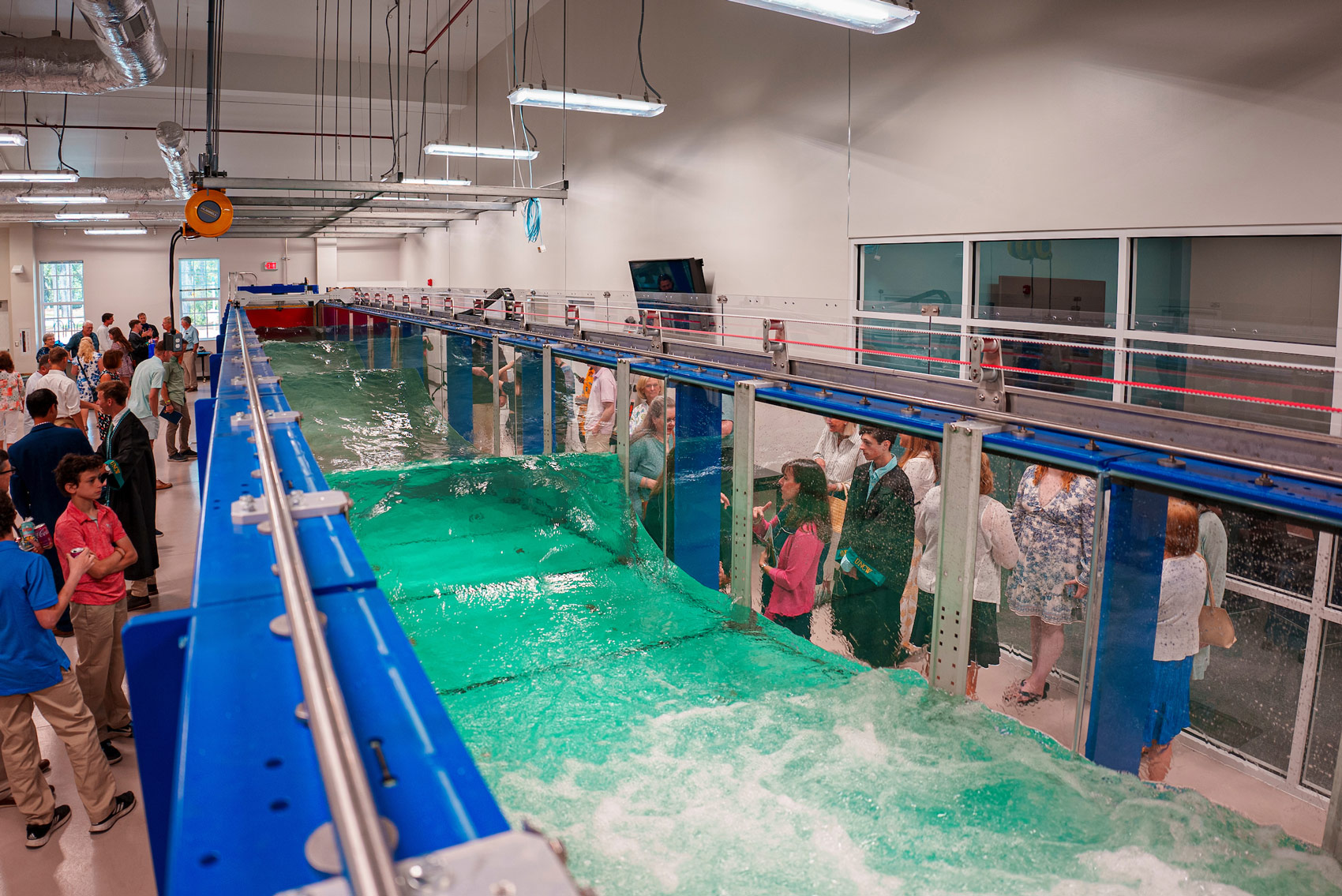Only wave flume this size in the southeast and Mid-Atlantic regions.

UNCW students and faculty in the undergraduate Coastal Engineering program now have new ways to study the power of ocean waves using a state-of-the-art wave flume installed right next to their classrooms.
Spanning nearly 80 feet long and 5 feet wide, the glass and steel tank, which can be seen off the main lobby of the department’s newly constructed building, holds 9,500 gallons of water —the equivalent of over 160 bathtubs full— and is just as aesthetically pleasing as it is useful.
According to Dr. Joe Long, director of UNCW’s Coastal Engineering program, there is no other wave flume this size or with these capabilities in the southeast and Mid-Atlantic regions.
“The wave flume is another tool in our back pocket to better understand our evolving coastline. As the state’s coastal university, we take our classes to the beach for teaching and research and now we can also step into our wave lab and conduct controlled lab and modeling experiments,” he said.
Science and engineering rely on a combination of coastal field measurements, numerical modeling and controlled laboratory experiments. Given UNCW’s coastal location, its experience in computer modeling and this new wave flume, the university can now use this trifecta for a wide range of innovative projects.
The flume can be programmed to mimic nature with calm or more energetic waves, and the slope of the bottom can be adjusted to better understand how waves break under different conditions. Researchers can also add sand to study how waves affect the ocean floor by creating turbulence and currents that move sediment and by creating sandbars.
A unique carriage that moves in two dimensions sits on top of the flume, giving researchers a platform to mount a range of instruments to measure movement of the water or sand up, down and across the tank.
“In nature, we can’t follow an individual wave or stop the waves to measure where the sand has moved. We can’t put a structure in place, run a wave condition, then change the structure and run the same wave condition to see if the performance changed,” Dr. Long explained. “With this equipment, students will be able to see complex concepts that we explain in the classroom up close and use the facility as part of research projects.”
The controlled and repeatable environment of the wave flume will also positively impact areas of research like instrument development; design of natural and nature-based features like seagrass marshes and living shorelines; and developing and testing computer models for how coastlines will evolve.
During the final days of the flume installation, a rubber duck painted to look like a Rubik’s Cube, borrowed from Assistant Professor Ryan Mieras’ notable collection, was seen bobbing along a continual set of rolling three-foot waves. The colorful duck added a playful note as a team from the Scottish company that designed and built the flume made the final adjustments and officially commissioned the tank.
"Edinburgh Designs is pleased to announce the completion of the new coastal wave flume at UNCW,” said Ian Jason, senior software engineer on the project. “By combining UNCW's expertise in coastal and ocean science with ED's extensive experience in hydrodynamic test equipment, we hope this advanced facility bolsters the university's teaching and research capabilities and inspires the next generation of coastal engineers. This milestone provides students with access to cutting-edge technology, solidifying our commitment to advancing hydrodynamic research."
The new wave flume has already had a number of visitors including school groups and professional societies and will be a benefit to STEM education in the region. In the future, Dr. Long anticipates that visiting researchers from other universities who don’t have this type of equipment will come to UNCW to conduct experiments, and entrepreneurs in the booming Wilmington startup community may also want to test new designs and innovative equipment.
This article has the following tags: Research & Innovation Academics


